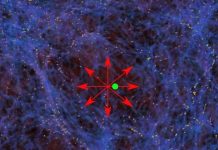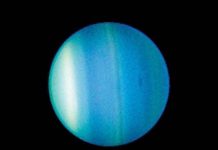
NASA’s Transiting Exoplanet Survey Satellite (TESS), launched in 2018 to explore planets beyond our solar system, has recently made a striking discovery.
UC Riverside astrophysicist Stephen Kane, while studying data from TESS, found a new planet with extreme volcanic activity, glowing with molten lava, located in a star system called HD 104067, about 66 light years away from Earth.
This newly discovered planet, named TOI-6713.01, is similar in composition to Earth but about 30% larger.
Unlike our home planet, TOI-6713.01 is more akin to Io, one of Jupiter’s moons, which is the most volcanically active body in our solar system.
However, TOI-6713.01 exhibits even more intense volcanic activity, earning it the nickname “Io on steroids” from Kane.
What makes this planet unique is its surface, which is so hot and active that it glows red, much like a ball of fire.
According to Kane’s calculations, the surface temperature reaches a scorching 2,600 degrees Kelvin, which is hotter than some stars. This high temperature is primarily due to the planet’s extreme volcanic activity.
The reason behind this fiery nature lies in the planet’s orbit. Similar to Io, TOI-6713.01 is squeezed by the gravitational forces of its neighboring planets.
This squeezing happens because the two other known planets in the HD 104067 system force TOI-6713.01 into an irregular, elliptical orbit around their star.
As TOI-6713.01 moves closer and farther from its star, the gravitational pull from these neighboring planets stretches and compresses it, heating it up through a process known as tidal energy.
This phenomenon is comparable to how tides on Earth are influenced by the moon’s gravity. However, instead of water being pulled, the planet itself is stretched, which heats up its internal structure and causes continuous volcanic eruptions.
Kane likens the ongoing stress on the planet to a racquetball being repeatedly hit in a heated game, getting hotter with each strike.
This constant gravitational tugging results in a surface bubbling with lava and an atmosphere filled with volcanic eruptions.
Looking ahead, Kane and his team are eager to measure the mass and density of TOI-6713.01. This information will help them understand how much material is being expelled through these volcanic eruptions and provide deeper insights into the composition of the planet.
This discovery not only adds to our understanding of planetary dynamics and extremes but also highlights the significance of tidal effects in shaping planetary environments, a topic that has been relatively understudied in exoplanet research.
By examining such extreme conditions, scientists can learn more about the forces that influence planetary formation and behavior across the universe.
In conclusion, the discovery of TOI-6713.01 offers a fascinating glimpse into the dynamic processes that can occur on planets outside our solar system, underscoring the diverse and often extreme nature of planets in our galaxy.
Source: UC Riverside.



